Business Law Case Study: Examining Slater & Gordon Ltd Under the Law
VerifiedAdded on 2023/06/12
|11
|2250
|361
Case Study
AI Summary
This case study examines the alleged deception by the directors of Slater & Gordon Ltd and their potential violations of the Corporation Act 2001. It identifies issues related to the directors' duties, potential defenses they might raise, and whether the corporate veil should be lifted. The analysis covers sections of the Act concerning good faith, misleading statements, and disclosure obligations. The study concludes that the directors may face legal action for misrepresenting financial information and failing to act in the best interests of shareholders, potentially leading to the piercing of the corporate veil to hold them personally liable. The document is available on Desklib, a platform providing study tools and solved assignments for students.
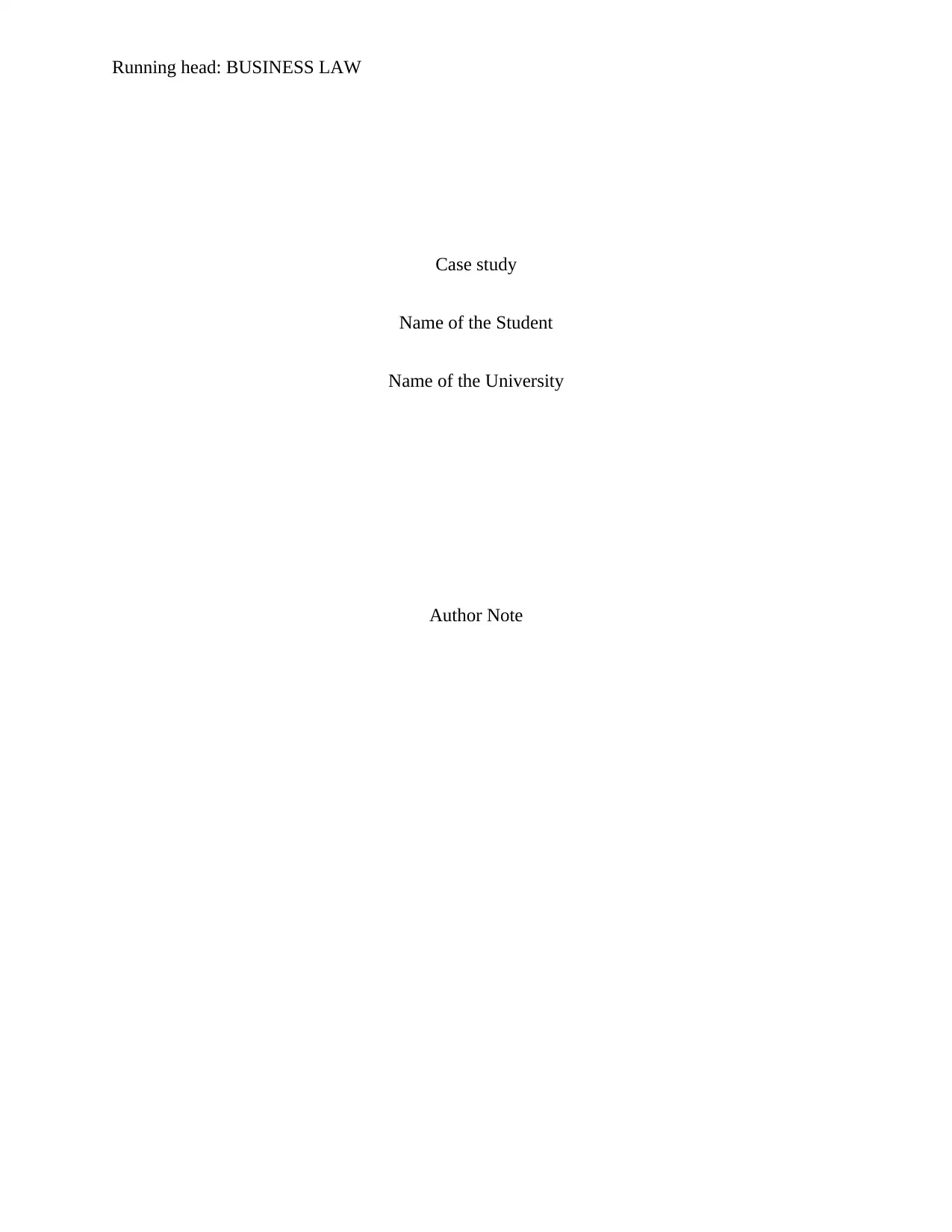
Running head: BUSINESS LAW
Case study
Name of the Student
Name of the University
Author Note
Case study
Name of the Student
Name of the University
Author Note
Paraphrase This Document
Need a fresh take? Get an instant paraphrase of this document with our AI Paraphraser
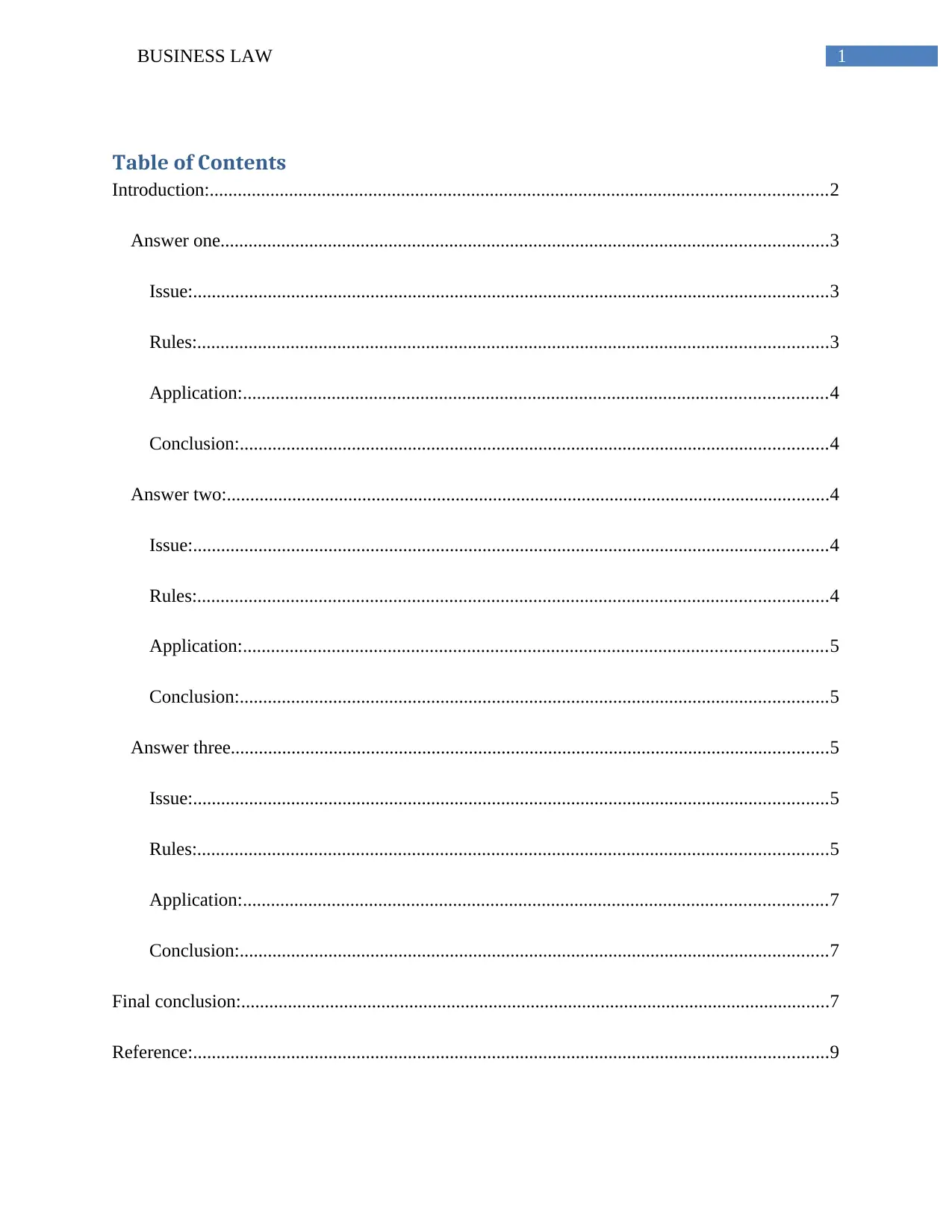
1BUSINESS LAW
Table of Contents
Introduction:....................................................................................................................................2
Answer one..................................................................................................................................3
Issue:........................................................................................................................................3
Rules:.......................................................................................................................................3
Application:.............................................................................................................................4
Conclusion:..............................................................................................................................4
Answer two:.................................................................................................................................4
Issue:........................................................................................................................................4
Rules:.......................................................................................................................................4
Application:.............................................................................................................................5
Conclusion:..............................................................................................................................5
Answer three................................................................................................................................5
Issue:........................................................................................................................................5
Rules:.......................................................................................................................................5
Application:.............................................................................................................................7
Conclusion:..............................................................................................................................7
Final conclusion:..............................................................................................................................7
Reference:........................................................................................................................................9
Table of Contents
Introduction:....................................................................................................................................2
Answer one..................................................................................................................................3
Issue:........................................................................................................................................3
Rules:.......................................................................................................................................3
Application:.............................................................................................................................4
Conclusion:..............................................................................................................................4
Answer two:.................................................................................................................................4
Issue:........................................................................................................................................4
Rules:.......................................................................................................................................4
Application:.............................................................................................................................5
Conclusion:..............................................................................................................................5
Answer three................................................................................................................................5
Issue:........................................................................................................................................5
Rules:.......................................................................................................................................5
Application:.............................................................................................................................7
Conclusion:..............................................................................................................................7
Final conclusion:..............................................................................................................................7
Reference:........................................................................................................................................9
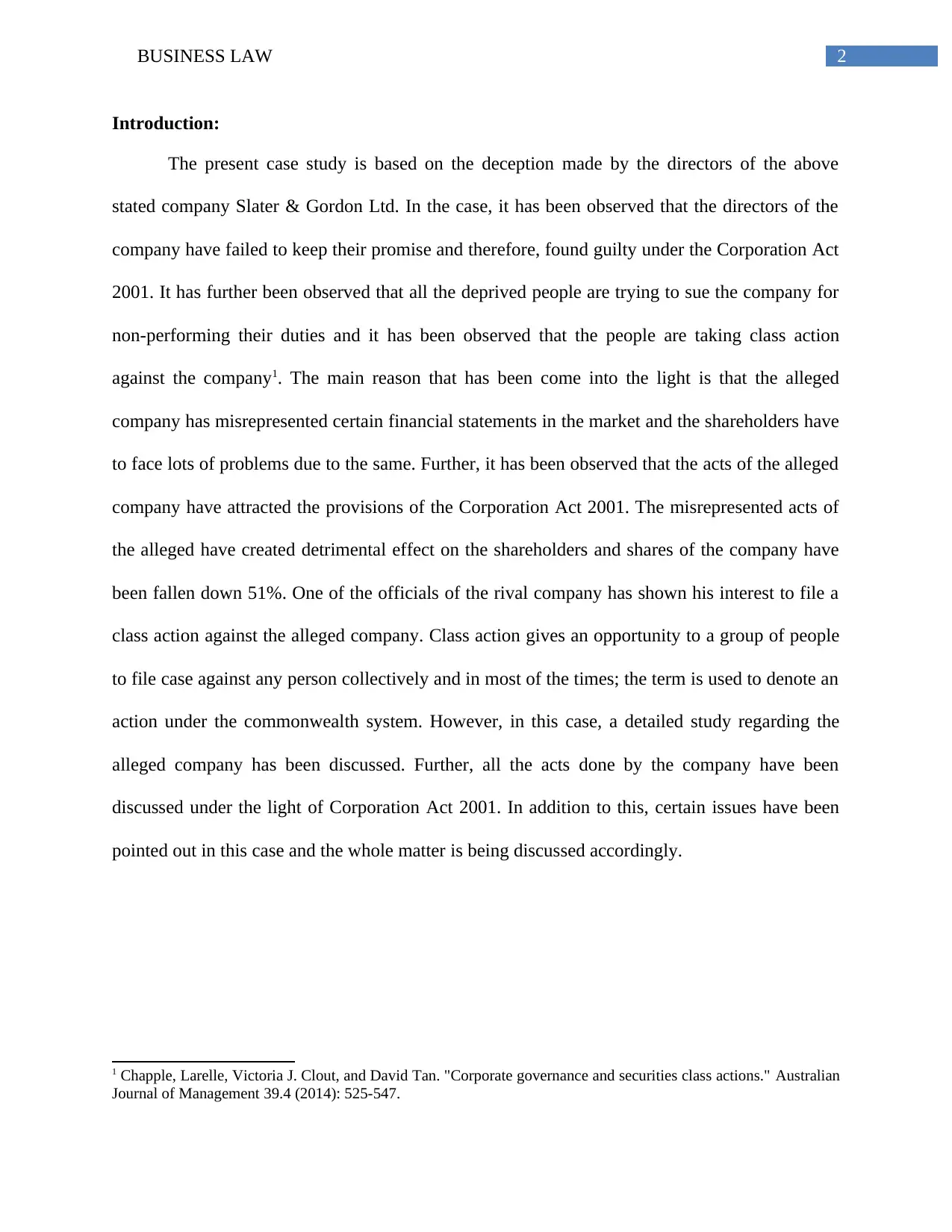
2BUSINESS LAW
Introduction:
The present case study is based on the deception made by the directors of the above
stated company Slater & Gordon Ltd. In the case, it has been observed that the directors of the
company have failed to keep their promise and therefore, found guilty under the Corporation Act
2001. It has further been observed that all the deprived people are trying to sue the company for
non-performing their duties and it has been observed that the people are taking class action
against the company1. The main reason that has been come into the light is that the alleged
company has misrepresented certain financial statements in the market and the shareholders have
to face lots of problems due to the same. Further, it has been observed that the acts of the alleged
company have attracted the provisions of the Corporation Act 2001. The misrepresented acts of
the alleged have created detrimental effect on the shareholders and shares of the company have
been fallen down 51%. One of the officials of the rival company has shown his interest to file a
class action against the alleged company. Class action gives an opportunity to a group of people
to file case against any person collectively and in most of the times; the term is used to denote an
action under the commonwealth system. However, in this case, a detailed study regarding the
alleged company has been discussed. Further, all the acts done by the company have been
discussed under the light of Corporation Act 2001. In addition to this, certain issues have been
pointed out in this case and the whole matter is being discussed accordingly.
1 Chapple, Larelle, Victoria J. Clout, and David Tan. "Corporate governance and securities class actions." Australian
Journal of Management 39.4 (2014): 525-547.
Introduction:
The present case study is based on the deception made by the directors of the above
stated company Slater & Gordon Ltd. In the case, it has been observed that the directors of the
company have failed to keep their promise and therefore, found guilty under the Corporation Act
2001. It has further been observed that all the deprived people are trying to sue the company for
non-performing their duties and it has been observed that the people are taking class action
against the company1. The main reason that has been come into the light is that the alleged
company has misrepresented certain financial statements in the market and the shareholders have
to face lots of problems due to the same. Further, it has been observed that the acts of the alleged
company have attracted the provisions of the Corporation Act 2001. The misrepresented acts of
the alleged have created detrimental effect on the shareholders and shares of the company have
been fallen down 51%. One of the officials of the rival company has shown his interest to file a
class action against the alleged company. Class action gives an opportunity to a group of people
to file case against any person collectively and in most of the times; the term is used to denote an
action under the commonwealth system. However, in this case, a detailed study regarding the
alleged company has been discussed. Further, all the acts done by the company have been
discussed under the light of Corporation Act 2001. In addition to this, certain issues have been
pointed out in this case and the whole matter is being discussed accordingly.
1 Chapple, Larelle, Victoria J. Clout, and David Tan. "Corporate governance and securities class actions." Australian
Journal of Management 39.4 (2014): 525-547.
⊘ This is a preview!⊘
Do you want full access?
Subscribe today to unlock all pages.

Trusted by 1+ million students worldwide

3BUSINESS LAW
Answer one
Issue:
The main issue of the first part of the case is to determine the legal provisions that the
alleged company has to face in respect of their activities.
Rules:
Considering the case, it has been observed that the directors of the company have failed
to perform their duties according to the provision of the Corporation Act. The directors in a
company is playing an important role in the corporation and certain provisions of the Act deal
with the rights and obligations of the directors. It has been mentioned in section 180 of the Act
that the directors of a company should act in good faith and they have certain duties for the
shareholders. The suitable provisions regarding the same are section 180 to section 183 and the
directors of the company have to act for the best interest of the company and the shareholders as
well. Further, it has been mentioned in section 728 of the Act that no director of the company is
allowed to describe a matter or document in such a way that results in misleading statement.
According to section 728 (2) of the Act, the directors are required to acquire sufficient
knowledge regarding the declaration they are making and interest of any other person should not
be affected by such declaration. If the director has failed to act accordingly, they will have to
face penalties under section 1041 of the Act. Further, they have to face penalties under section
1317E of the Act for non-performing their duties mentioned in section 180 to section 183 of the
Corporation Act 2001.
Answer one
Issue:
The main issue of the first part of the case is to determine the legal provisions that the
alleged company has to face in respect of their activities.
Rules:
Considering the case, it has been observed that the directors of the company have failed
to perform their duties according to the provision of the Corporation Act. The directors in a
company is playing an important role in the corporation and certain provisions of the Act deal
with the rights and obligations of the directors. It has been mentioned in section 180 of the Act
that the directors of a company should act in good faith and they have certain duties for the
shareholders. The suitable provisions regarding the same are section 180 to section 183 and the
directors of the company have to act for the best interest of the company and the shareholders as
well. Further, it has been mentioned in section 728 of the Act that no director of the company is
allowed to describe a matter or document in such a way that results in misleading statement.
According to section 728 (2) of the Act, the directors are required to acquire sufficient
knowledge regarding the declaration they are making and interest of any other person should not
be affected by such declaration. If the director has failed to act accordingly, they will have to
face penalties under section 1041 of the Act. Further, they have to face penalties under section
1317E of the Act for non-performing their duties mentioned in section 180 to section 183 of the
Corporation Act 2001.
Paraphrase This Document
Need a fresh take? Get an instant paraphrase of this document with our AI Paraphraser
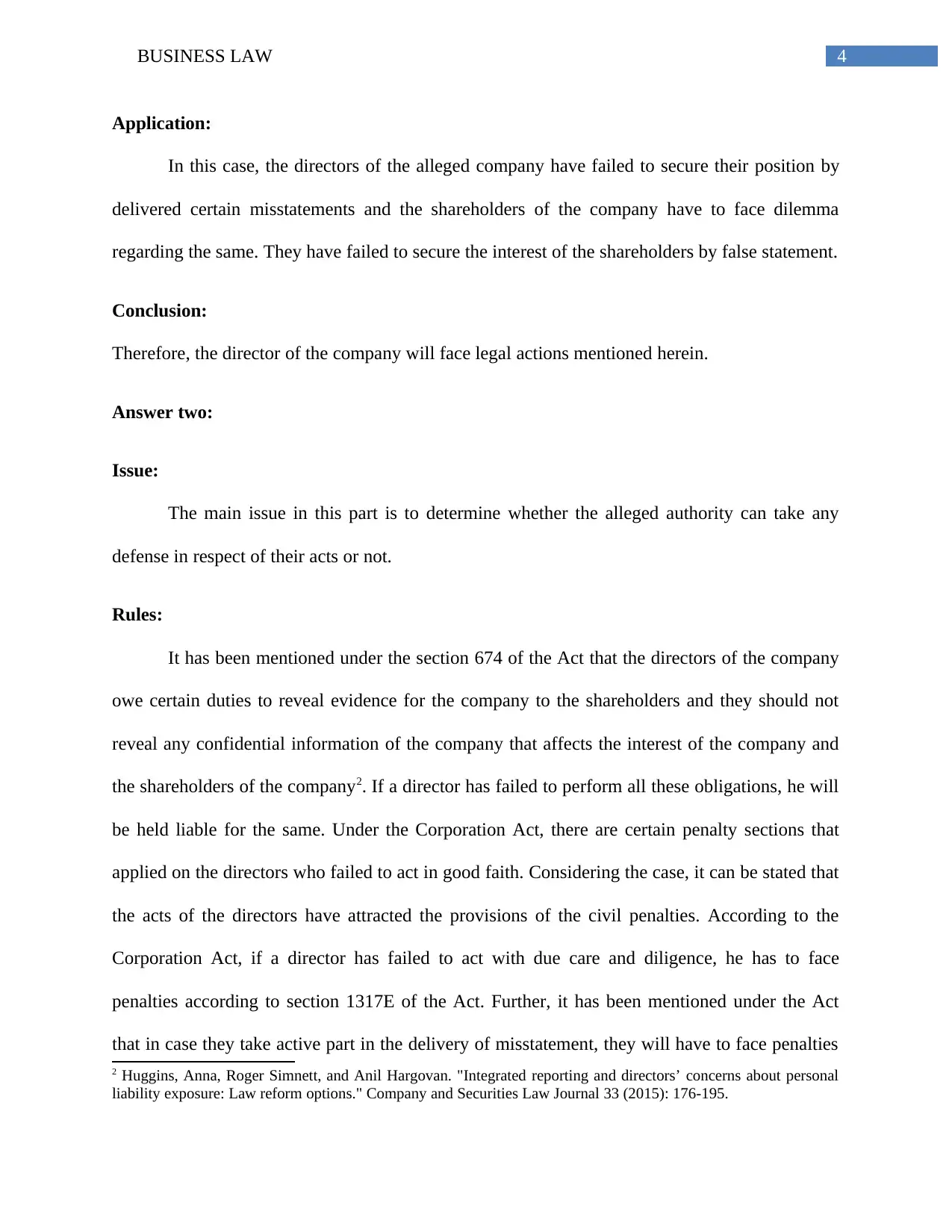
4BUSINESS LAW
Application:
In this case, the directors of the alleged company have failed to secure their position by
delivered certain misstatements and the shareholders of the company have to face dilemma
regarding the same. They have failed to secure the interest of the shareholders by false statement.
Conclusion:
Therefore, the director of the company will face legal actions mentioned herein.
Answer two:
Issue:
The main issue in this part is to determine whether the alleged authority can take any
defense in respect of their acts or not.
Rules:
It has been mentioned under the section 674 of the Act that the directors of the company
owe certain duties to reveal evidence for the company to the shareholders and they should not
reveal any confidential information of the company that affects the interest of the company and
the shareholders of the company2. If a director has failed to perform all these obligations, he will
be held liable for the same. Under the Corporation Act, there are certain penalty sections that
applied on the directors who failed to act in good faith. Considering the case, it can be stated that
the acts of the directors have attracted the provisions of the civil penalties. According to the
Corporation Act, if a director has failed to act with due care and diligence, he has to face
penalties according to section 1317E of the Act. Further, it has been mentioned under the Act
that in case they take active part in the delivery of misstatement, they will have to face penalties
2 Huggins, Anna, Roger Simnett, and Anil Hargovan. "Integrated reporting and directors’ concerns about personal
liability exposure: Law reform options." Company and Securities Law Journal 33 (2015): 176-195.
Application:
In this case, the directors of the alleged company have failed to secure their position by
delivered certain misstatements and the shareholders of the company have to face dilemma
regarding the same. They have failed to secure the interest of the shareholders by false statement.
Conclusion:
Therefore, the director of the company will face legal actions mentioned herein.
Answer two:
Issue:
The main issue in this part is to determine whether the alleged authority can take any
defense in respect of their acts or not.
Rules:
It has been mentioned under the section 674 of the Act that the directors of the company
owe certain duties to reveal evidence for the company to the shareholders and they should not
reveal any confidential information of the company that affects the interest of the company and
the shareholders of the company2. If a director has failed to perform all these obligations, he will
be held liable for the same. Under the Corporation Act, there are certain penalty sections that
applied on the directors who failed to act in good faith. Considering the case, it can be stated that
the acts of the directors have attracted the provisions of the civil penalties. According to the
Corporation Act, if a director has failed to act with due care and diligence, he has to face
penalties according to section 1317E of the Act. Further, it has been mentioned under the Act
that in case they take active part in the delivery of misstatement, they will have to face penalties
2 Huggins, Anna, Roger Simnett, and Anil Hargovan. "Integrated reporting and directors’ concerns about personal
liability exposure: Law reform options." Company and Securities Law Journal 33 (2015): 176-195.
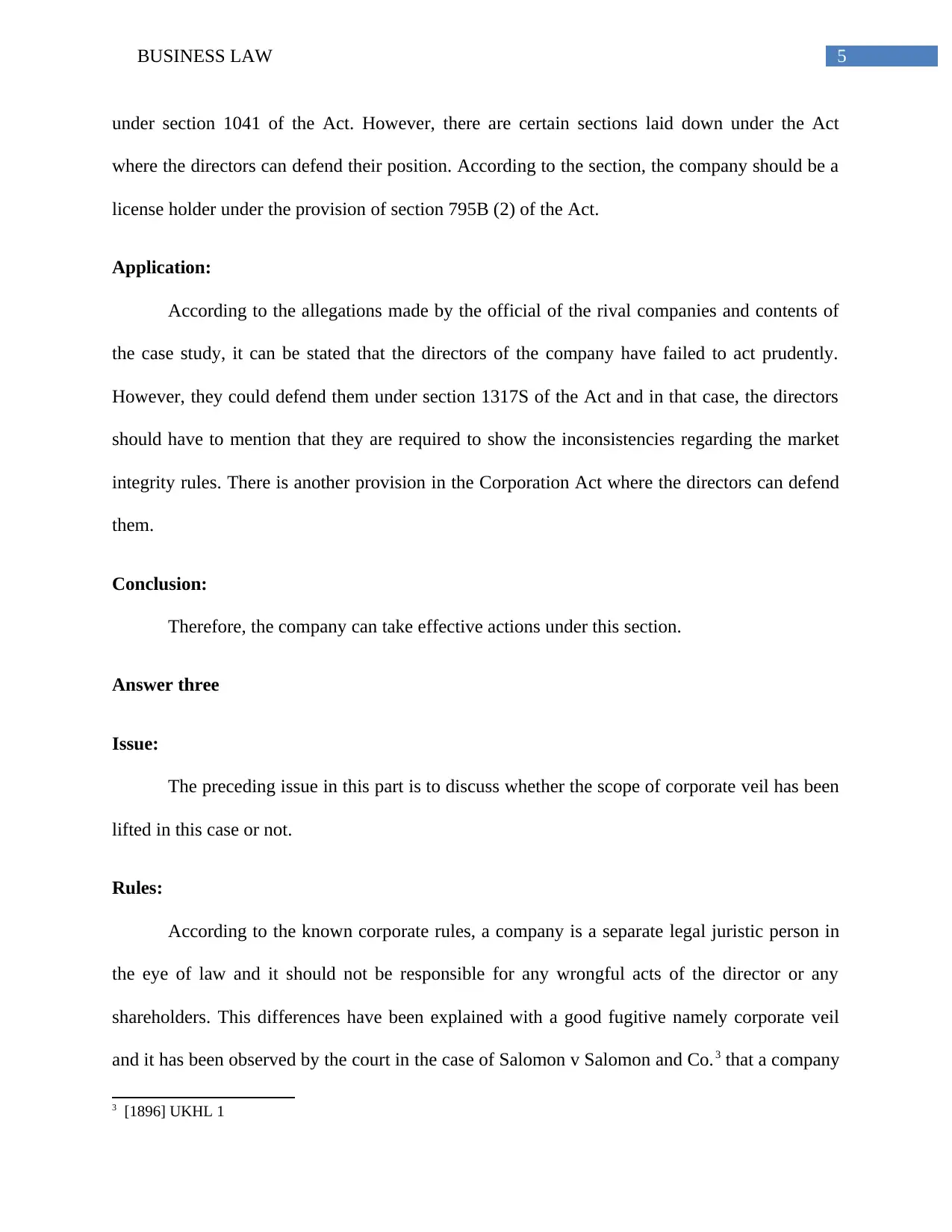
5BUSINESS LAW
under section 1041 of the Act. However, there are certain sections laid down under the Act
where the directors can defend their position. According to the section, the company should be a
license holder under the provision of section 795B (2) of the Act.
Application:
According to the allegations made by the official of the rival companies and contents of
the case study, it can be stated that the directors of the company have failed to act prudently.
However, they could defend them under section 1317S of the Act and in that case, the directors
should have to mention that they are required to show the inconsistencies regarding the market
integrity rules. There is another provision in the Corporation Act where the directors can defend
them.
Conclusion:
Therefore, the company can take effective actions under this section.
Answer three
Issue:
The preceding issue in this part is to discuss whether the scope of corporate veil has been
lifted in this case or not.
Rules:
According to the known corporate rules, a company is a separate legal juristic person in
the eye of law and it should not be responsible for any wrongful acts of the director or any
shareholders. This differences have been explained with a good fugitive namely corporate veil
and it has been observed by the court in the case of Salomon v Salomon and Co.3 that a company
3 [1896] UKHL 1
under section 1041 of the Act. However, there are certain sections laid down under the Act
where the directors can defend their position. According to the section, the company should be a
license holder under the provision of section 795B (2) of the Act.
Application:
According to the allegations made by the official of the rival companies and contents of
the case study, it can be stated that the directors of the company have failed to act prudently.
However, they could defend them under section 1317S of the Act and in that case, the directors
should have to mention that they are required to show the inconsistencies regarding the market
integrity rules. There is another provision in the Corporation Act where the directors can defend
them.
Conclusion:
Therefore, the company can take effective actions under this section.
Answer three
Issue:
The preceding issue in this part is to discuss whether the scope of corporate veil has been
lifted in this case or not.
Rules:
According to the known corporate rules, a company is a separate legal juristic person in
the eye of law and it should not be responsible for any wrongful acts of the director or any
shareholders. This differences have been explained with a good fugitive namely corporate veil
and it has been observed by the court in the case of Salomon v Salomon and Co.3 that a company
3 [1896] UKHL 1
⊘ This is a preview!⊘
Do you want full access?
Subscribe today to unlock all pages.

Trusted by 1+ million students worldwide
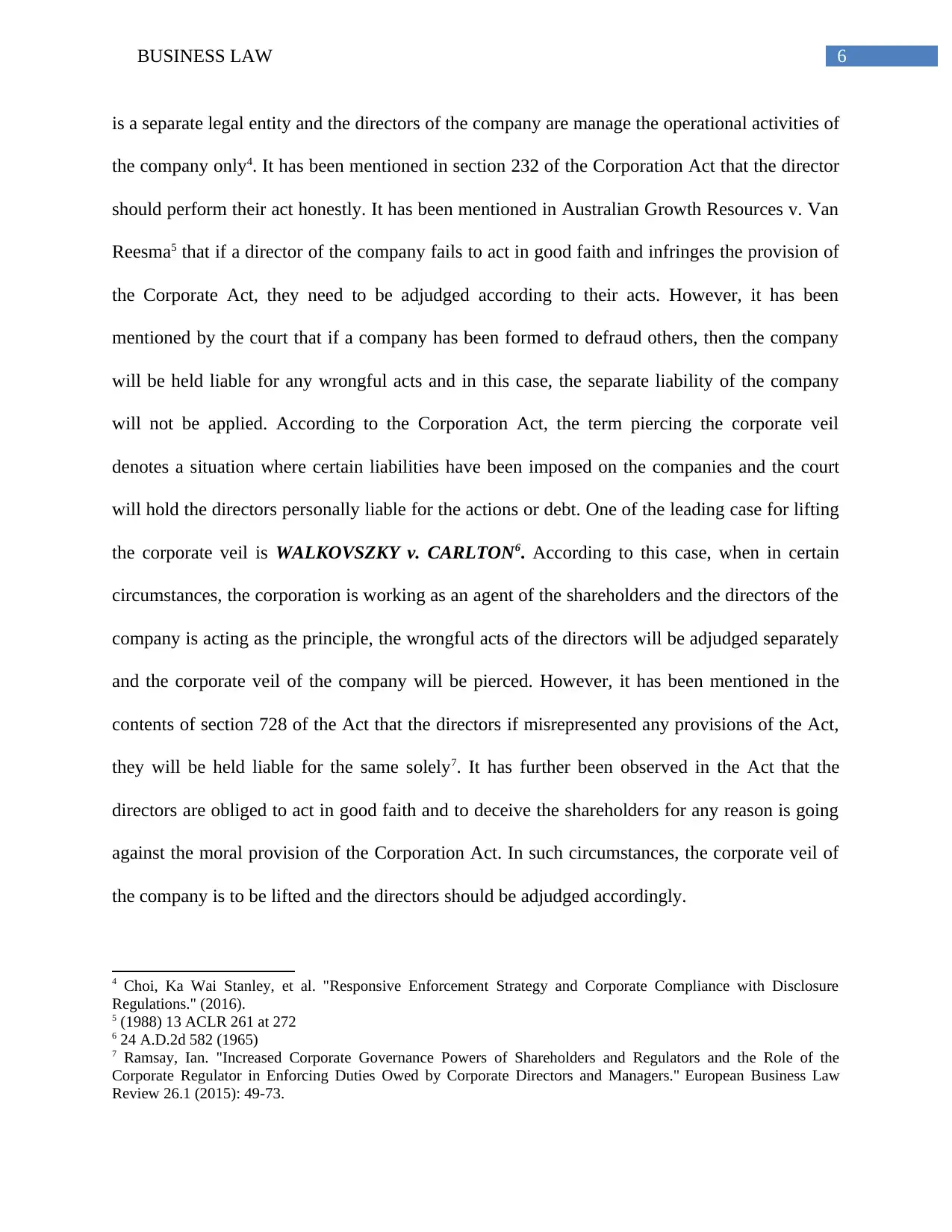
6BUSINESS LAW
is a separate legal entity and the directors of the company are manage the operational activities of
the company only4. It has been mentioned in section 232 of the Corporation Act that the director
should perform their act honestly. It has been mentioned in Australian Growth Resources v. Van
Reesma5 that if a director of the company fails to act in good faith and infringes the provision of
the Corporate Act, they need to be adjudged according to their acts. However, it has been
mentioned by the court that if a company has been formed to defraud others, then the company
will be held liable for any wrongful acts and in this case, the separate liability of the company
will not be applied. According to the Corporation Act, the term piercing the corporate veil
denotes a situation where certain liabilities have been imposed on the companies and the court
will hold the directors personally liable for the actions or debt. One of the leading case for lifting
the corporate veil is WALKOVSZKY v. CARLTON6. According to this case, when in certain
circumstances, the corporation is working as an agent of the shareholders and the directors of the
company is acting as the principle, the wrongful acts of the directors will be adjudged separately
and the corporate veil of the company will be pierced. However, it has been mentioned in the
contents of section 728 of the Act that the directors if misrepresented any provisions of the Act,
they will be held liable for the same solely7. It has further been observed in the Act that the
directors are obliged to act in good faith and to deceive the shareholders for any reason is going
against the moral provision of the Corporation Act. In such circumstances, the corporate veil of
the company is to be lifted and the directors should be adjudged accordingly.
4 Choi, Ka Wai Stanley, et al. "Responsive Enforcement Strategy and Corporate Compliance with Disclosure
Regulations." (2016).
5 (1988) 13 ACLR 261 at 272
6 24 A.D.2d 582 (1965)
7 Ramsay, Ian. "Increased Corporate Governance Powers of Shareholders and Regulators and the Role of the
Corporate Regulator in Enforcing Duties Owed by Corporate Directors and Managers." European Business Law
Review 26.1 (2015): 49-73.
is a separate legal entity and the directors of the company are manage the operational activities of
the company only4. It has been mentioned in section 232 of the Corporation Act that the director
should perform their act honestly. It has been mentioned in Australian Growth Resources v. Van
Reesma5 that if a director of the company fails to act in good faith and infringes the provision of
the Corporate Act, they need to be adjudged according to their acts. However, it has been
mentioned by the court that if a company has been formed to defraud others, then the company
will be held liable for any wrongful acts and in this case, the separate liability of the company
will not be applied. According to the Corporation Act, the term piercing the corporate veil
denotes a situation where certain liabilities have been imposed on the companies and the court
will hold the directors personally liable for the actions or debt. One of the leading case for lifting
the corporate veil is WALKOVSZKY v. CARLTON6. According to this case, when in certain
circumstances, the corporation is working as an agent of the shareholders and the directors of the
company is acting as the principle, the wrongful acts of the directors will be adjudged separately
and the corporate veil of the company will be pierced. However, it has been mentioned in the
contents of section 728 of the Act that the directors if misrepresented any provisions of the Act,
they will be held liable for the same solely7. It has further been observed in the Act that the
directors are obliged to act in good faith and to deceive the shareholders for any reason is going
against the moral provision of the Corporation Act. In such circumstances, the corporate veil of
the company is to be lifted and the directors should be adjudged accordingly.
4 Choi, Ka Wai Stanley, et al. "Responsive Enforcement Strategy and Corporate Compliance with Disclosure
Regulations." (2016).
5 (1988) 13 ACLR 261 at 272
6 24 A.D.2d 582 (1965)
7 Ramsay, Ian. "Increased Corporate Governance Powers of Shareholders and Regulators and the Role of the
Corporate Regulator in Enforcing Duties Owed by Corporate Directors and Managers." European Business Law
Review 26.1 (2015): 49-73.
Paraphrase This Document
Need a fresh take? Get an instant paraphrase of this document with our AI Paraphraser

7BUSINESS LAW
Application:
It has been observed in the case that the directors of the alleged company have misled the
statement made to the shareholders for the financial information. The directors have promised it
to the shareholders that the financial condition of the company will be good and they will get
their share accordingly. The director of the company has failed to perform their duties as per the
provision mentioned in section 180 to section 183 of the Corporation Act. Further, it has been
observed that the director of the company misled the shareholders of the company and did not
disclose important information to the shareholders according to section 674 of the Act.
Therefore, the director should have to face the penalties solely. Further, it is to be stated that the
corporate veil of the company in this case should be pierced.
Conclusion:
Therefore, the corporate veil of the company is required to be pierced in this case.
Final conclusion:
After a thorough look over into the case study, it has been observed that there are several
provisions for taking class action against the company. The directors of the company have failed
to perform their obligations in good faith. It has further been stated that the directors have failed
to disclose necessary documents to the shareholders. Further, they had made false promise to the
shareholders regarding the profitability of the company, kept the shareholders in darkness, and
failed to act on behalf of the interest of the shareholders. The directors of the alleged company
have attracted the provisions of section 674 and section 728 of the Corporation Act. To conclude,
it can be stated that the corporate veil in this case is required to be pierced to identify the
offences of the directors.
Application:
It has been observed in the case that the directors of the alleged company have misled the
statement made to the shareholders for the financial information. The directors have promised it
to the shareholders that the financial condition of the company will be good and they will get
their share accordingly. The director of the company has failed to perform their duties as per the
provision mentioned in section 180 to section 183 of the Corporation Act. Further, it has been
observed that the director of the company misled the shareholders of the company and did not
disclose important information to the shareholders according to section 674 of the Act.
Therefore, the director should have to face the penalties solely. Further, it is to be stated that the
corporate veil of the company in this case should be pierced.
Conclusion:
Therefore, the corporate veil of the company is required to be pierced in this case.
Final conclusion:
After a thorough look over into the case study, it has been observed that there are several
provisions for taking class action against the company. The directors of the company have failed
to perform their obligations in good faith. It has further been stated that the directors have failed
to disclose necessary documents to the shareholders. Further, they had made false promise to the
shareholders regarding the profitability of the company, kept the shareholders in darkness, and
failed to act on behalf of the interest of the shareholders. The directors of the alleged company
have attracted the provisions of section 674 and section 728 of the Corporation Act. To conclude,
it can be stated that the corporate veil in this case is required to be pierced to identify the
offences of the directors.
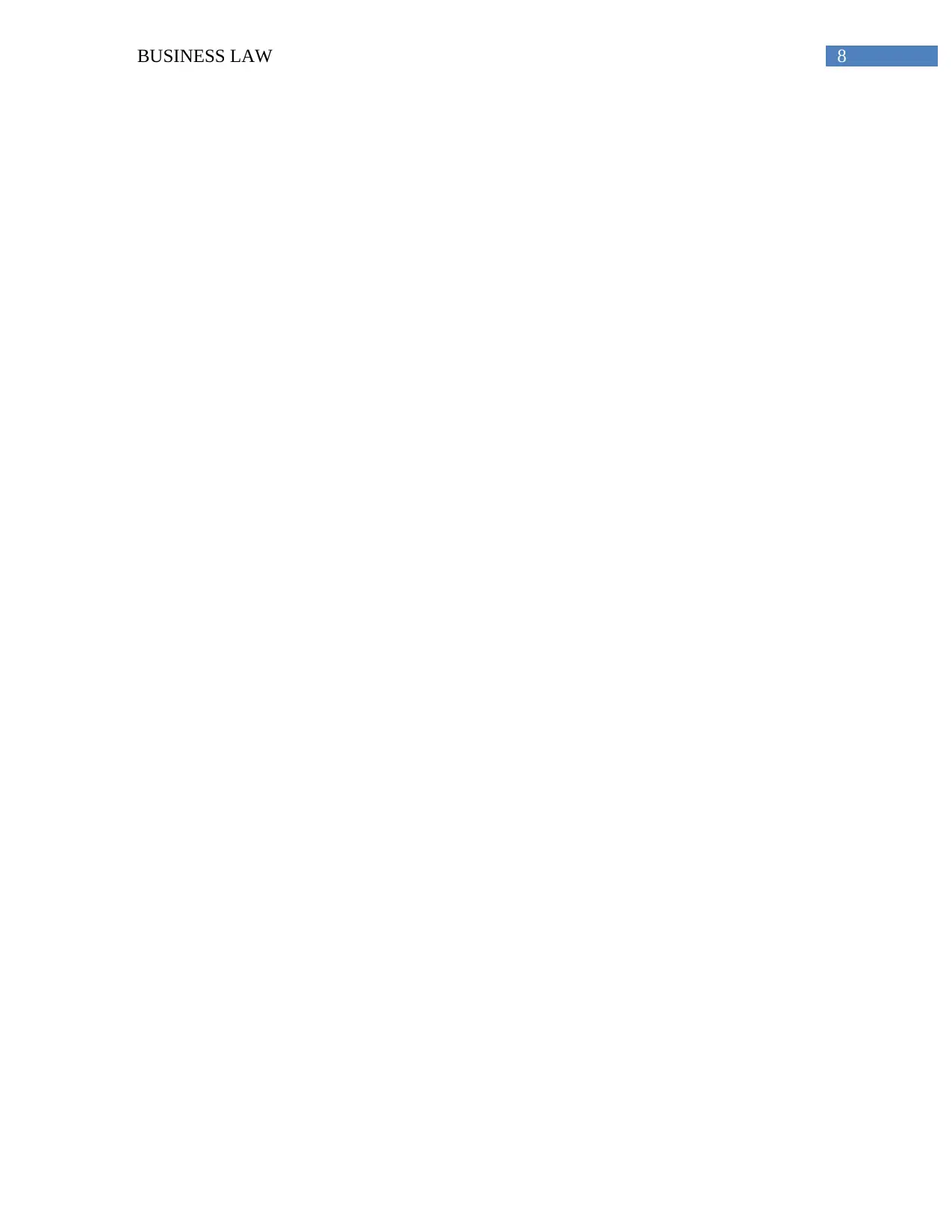
8BUSINESS LAW
⊘ This is a preview!⊘
Do you want full access?
Subscribe today to unlock all pages.

Trusted by 1+ million students worldwide
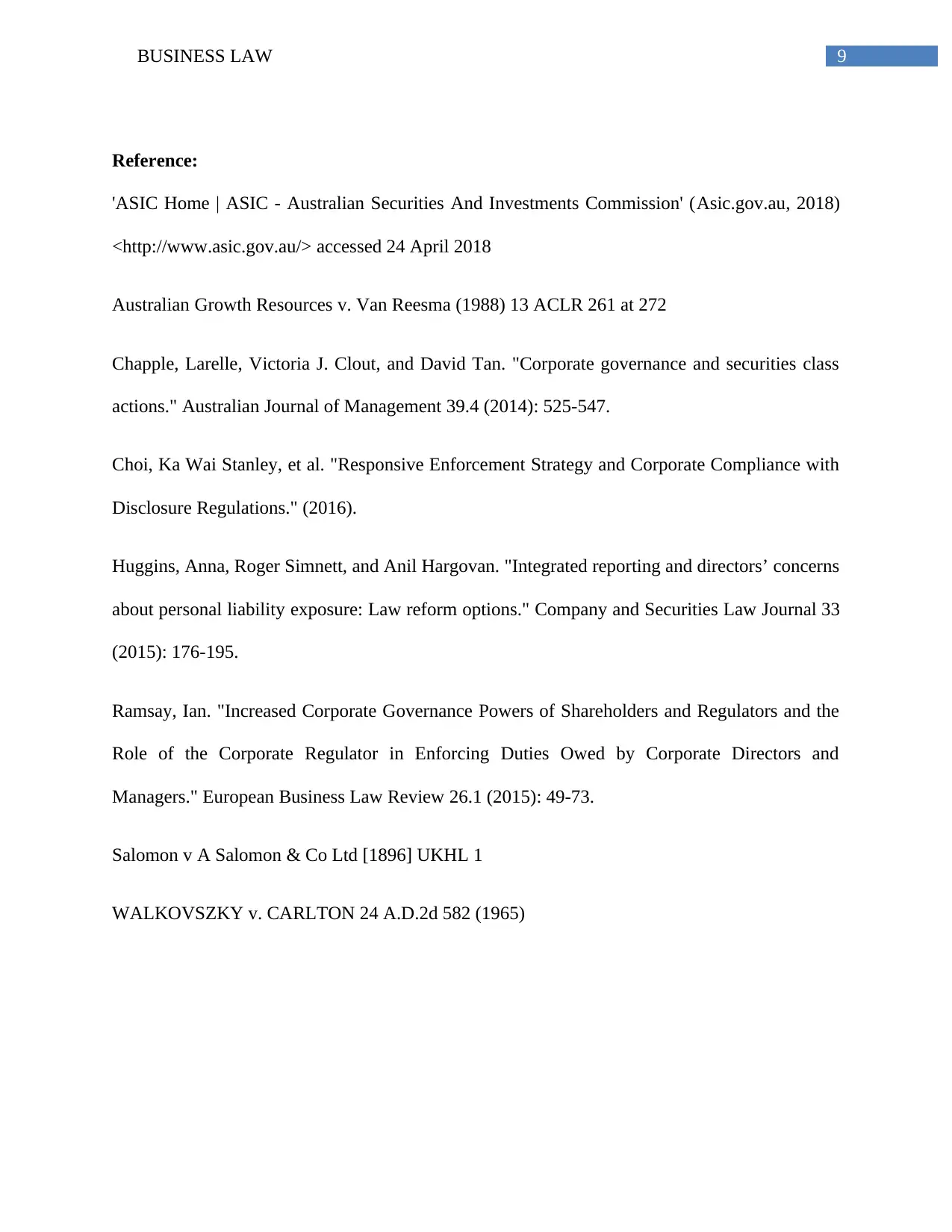
9BUSINESS LAW
Reference:
'ASIC Home | ASIC - Australian Securities And Investments Commission' (Asic.gov.au, 2018)
<http://www.asic.gov.au/> accessed 24 April 2018
Australian Growth Resources v. Van Reesma (1988) 13 ACLR 261 at 272
Chapple, Larelle, Victoria J. Clout, and David Tan. "Corporate governance and securities class
actions." Australian Journal of Management 39.4 (2014): 525-547.
Choi, Ka Wai Stanley, et al. "Responsive Enforcement Strategy and Corporate Compliance with
Disclosure Regulations." (2016).
Huggins, Anna, Roger Simnett, and Anil Hargovan. "Integrated reporting and directors’ concerns
about personal liability exposure: Law reform options." Company and Securities Law Journal 33
(2015): 176-195.
Ramsay, Ian. "Increased Corporate Governance Powers of Shareholders and Regulators and the
Role of the Corporate Regulator in Enforcing Duties Owed by Corporate Directors and
Managers." European Business Law Review 26.1 (2015): 49-73.
Salomon v A Salomon & Co Ltd [1896] UKHL 1
WALKOVSZKY v. CARLTON 24 A.D.2d 582 (1965)
Reference:
'ASIC Home | ASIC - Australian Securities And Investments Commission' (Asic.gov.au, 2018)
<http://www.asic.gov.au/> accessed 24 April 2018
Australian Growth Resources v. Van Reesma (1988) 13 ACLR 261 at 272
Chapple, Larelle, Victoria J. Clout, and David Tan. "Corporate governance and securities class
actions." Australian Journal of Management 39.4 (2014): 525-547.
Choi, Ka Wai Stanley, et al. "Responsive Enforcement Strategy and Corporate Compliance with
Disclosure Regulations." (2016).
Huggins, Anna, Roger Simnett, and Anil Hargovan. "Integrated reporting and directors’ concerns
about personal liability exposure: Law reform options." Company and Securities Law Journal 33
(2015): 176-195.
Ramsay, Ian. "Increased Corporate Governance Powers of Shareholders and Regulators and the
Role of the Corporate Regulator in Enforcing Duties Owed by Corporate Directors and
Managers." European Business Law Review 26.1 (2015): 49-73.
Salomon v A Salomon & Co Ltd [1896] UKHL 1
WALKOVSZKY v. CARLTON 24 A.D.2d 582 (1965)
Paraphrase This Document
Need a fresh take? Get an instant paraphrase of this document with our AI Paraphraser
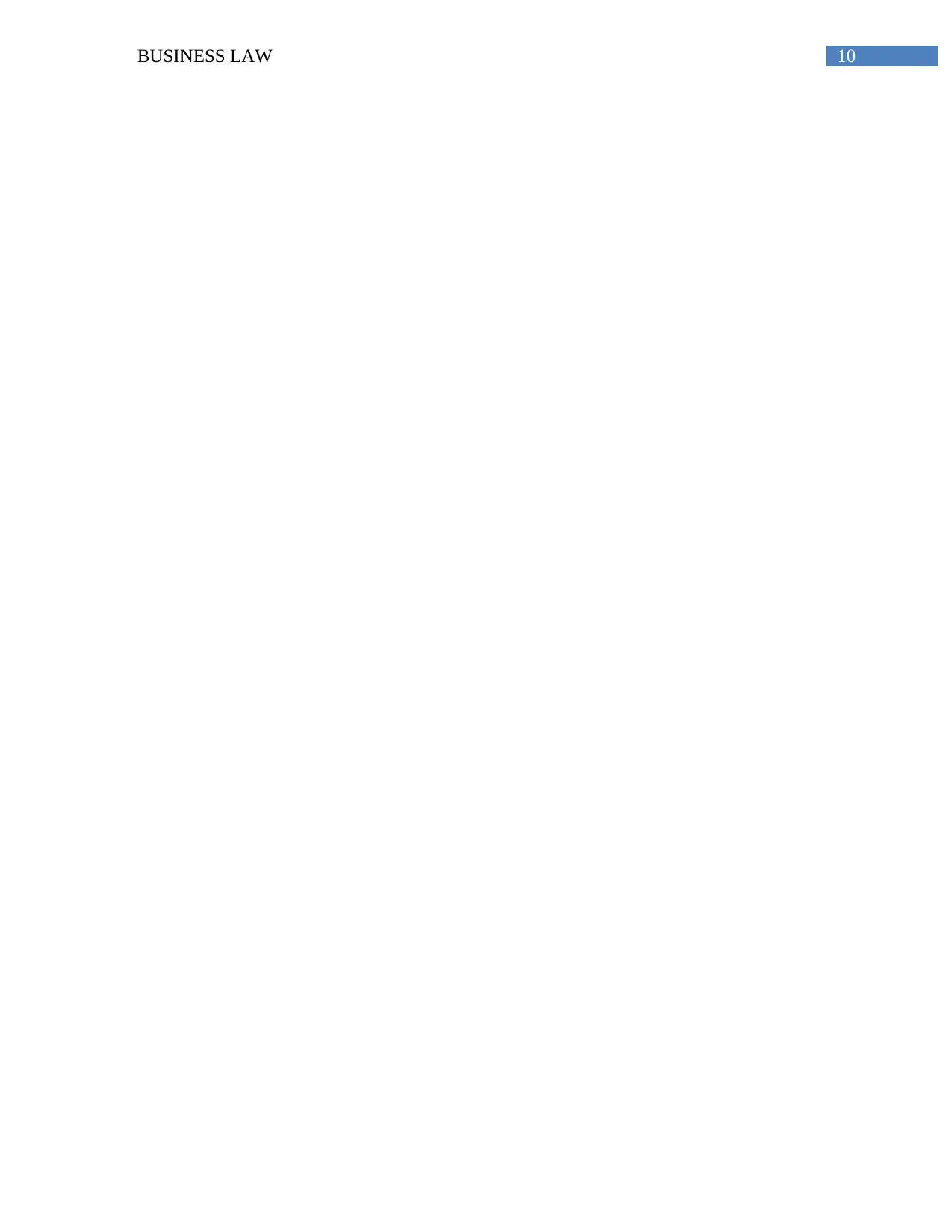
10BUSINESS LAW
1 out of 11
Related Documents
Your All-in-One AI-Powered Toolkit for Academic Success.
+13062052269
info@desklib.com
Available 24*7 on WhatsApp / Email
![[object Object]](/_next/static/media/star-bottom.7253800d.svg)
Unlock your academic potential
Copyright © 2020–2025 A2Z Services. All Rights Reserved. Developed and managed by ZUCOL.





